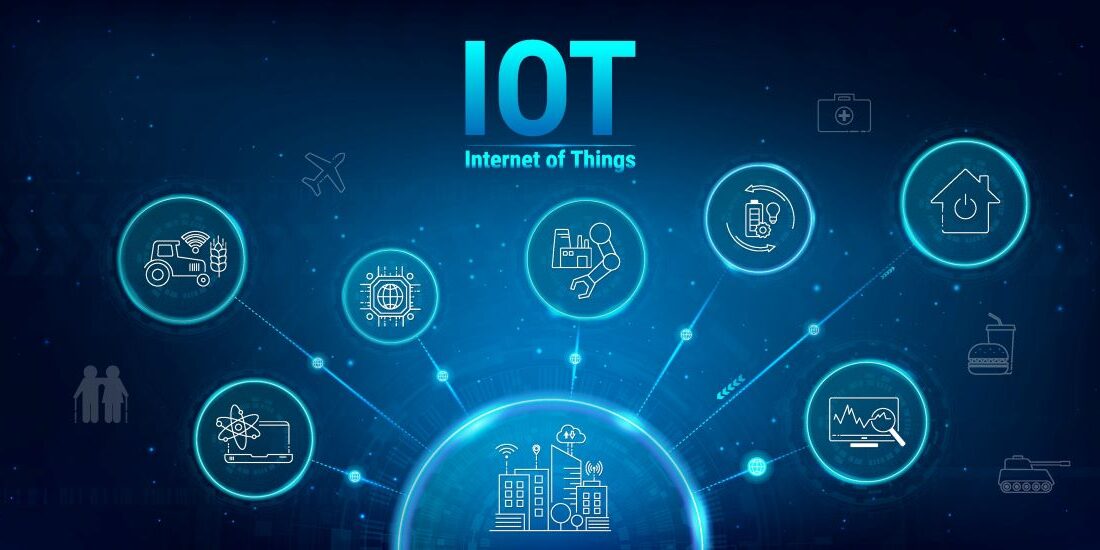


The state of the IoT market
IoT Analytics predicts the IoT market to grow at a CAGR of 22.0% to $525 billion between 2022 and 2027. Despite the lower projected growth, IoT is still a hot technology topic, with many projects entering the implementation phase. Several economic expansion tailwinds have had a far more significant effect than initially expected, including supply constraints, breakdowns, and staff shortages, particularly for highly sought-after technology jobs. As an aspect of our prediction, we looked into how essential concepts and trends in economics, politics, the environment, and technological advancements affect the IoT’s future growth.
There are 12 macro factors in IoT markets in these four sectors.
Economic Factors
The International Monetary Fund forecasted 4.4% GDP growth in 2022 in its January 2022 World Economic Outlook, following a 5.9% expansion in 2021. IMF economic experts have already reduced the growth forecast for 2022 by a half point since October 2021, as rising inflation, rising COVID-19 cases, and general supply chain issues became evident. The company’s overall trust and the recovery in personal spending are lower than expected, weighing on business growth.
Rising input costs
In most economic systems, the price level is rapidly rising. Rising energy, commodity, and food prices have begun to impact businesses. Goldman Sachs stated that it is becoming greatly worried about rising costs and has raised its inflation forecast for 2022. As profitability pressure from inflation grows, businesses will turn to IoT as a tool to improve processes and invest in cost-cutting actions.
The impact of rising inflation on IoT may thus be mitigated. However, the overall effect of this benefit will be insufficient to offset the negative economic consequences of rising input prices. Disruptive technology valuations are falling. To combat inflation, crucial financial institutions are intended to increase interest rates significantly in the following months.
Supply chains that are unsteady
Supply chain disturbance became a big issue throughout 2021 due to various factors such as COVID-19 lockdowns, vessel shortages, and the blocked Suez Canal.
Nearshoring/Reshoring
Because of unsteady supply chains, many businesses are shifting from a direct distribution strategy to various approaches to offer more options in the event of potential disruption. Given the comparatively high labor costs in the US and Europe, businesses must engage in cutting-edge production facilities and Industry 4.0 to remain competitive. This initiative will result in new investments in advanced production facilities in countries with relatively high wage levels. Russia has invaded Ukraine.
The sanctions against Russia are expected to have a negligible impact other than limiting Russia’s IoT market size growth.
The European Data Protection Act
The European Data Act, which is expected to come into influence in 2023, could positively impact tech competition. The European Commission plans to adopt a guideline that will allow customers to switch between cloud storage service providers while also constructing safeguards against unauthorized data transmission.
Sustainability purposes
Sustainability-focused use cases like IoT-based power management, sustainable energy management, and linked HVAC are anticipated to be popular. Extreme weather events, such as those seen in early 2022, will guarantee to change climate continues to experience attention and will lead to additional investments in renewable energy and carbon neutrality to mitigate the effects.
Reducing reliance on fossil fuels
In March 2022, Saudi Arabia will kick off a $5 billion green hydrogen project. The project intends to use wind and solar energy to electrolyze more than 650 tons of hydrogen daily. Increased EVs and EV charging facilities, as well as investments in new and eco-friendly energy sources, are likely to spur assets in smart grid and intelligent city remedies, as well as a significant rise in IoT spending from the energy sector.
Living with COVID-19
Despite billions of vaccination doses being administrated, the world has shifted from a narrative of «ending COVID-19» to «living with COVID-19,» and COVID-19 cases are on the rise in many parts of the world. COVID-19 is now more lethal than the flu in England, thanks to a high proportion of the vaccinated population and the less dangerous Omicron variant.
Artificial intelligence development
The accessibility of new development tools, the development of simplified AI solutions, the incorporation of AI into legacy systems, and advancements in AI hardware are all expected to drive the Artificial Intelligence of Things market, which we approximate will achieve $102.2 billion by 2026. In many ways, hyperscalers have become the IoT’s backbone, and their continued high dedication is expected to accelerate overall IoT market size growth in the coming years.
Growing Connectivity
The ability to obtain more powerful connectivity at lower prices fuels the IoT market.
A rise in cybersecurity incidents
Following a cyberattack, the world’s largest meat supplier was forced to halt production. These examples highlight the threats associated with IoT and will be a source of concern for the industry for some time.
Chip Shortage
Due to a global supply shortage, 20 million cellular IoT chips were lacking in 2021. The technology sector and its customers still suffer from a severe supply shortage. The scarcity is expected to limit growth in 2022 and 2023, at the very least. Intel recently announced an €80 billion investment in research and development, “state-of-the-art packaging technologies”, and production. Technological advancements are typically tailwinds for technology markets. The European Union is investing billions of dollars to achieve its goal of «having 20% of global chip market share by 2030». Still, we are in an unusual situation where the supply of chipsets has grown so large that a supply shortage will restrict IoT project rollout for at least the next two years.




